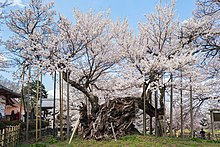Japan's Top 3: Difference between revisions
ChubbyWimbus (talk | contribs) →Temples: Switching out overused image |
|||
| Line 203: | Line 203: | ||
===Three Famous Big Buddhas=== |
===Three Famous Big Buddhas=== |
||
[[ |
[[File: |
||
Revision as of 14:40, 7 May 2024
After the Three Views were composed in the 17th century, many authors have come up with their own lists of Japanese sites and attractions. While there are countless lists and variations thereof, here is a selection of the best-known ones:
Views
Three Views

Sankei (
New Three Views
Three Great Night Views

- Hakodate seen from Mount Hakodate
- Kobe and Osaka Bay seen from Mount Rokko
- Nagasaki seen from Mount Inasa
New Three Great Night Views
- Kitakyushu seen from Mount Sarakurayama
- Nara seen from Mount Wakakusayama
- Yamanashi seen from Fuefuki River Fruit Park
Castles


Three Famous Castles
Three Great Mountain Castles
Three Great Flatland Mountain Castles
- Himeji Castle in Himeji, Hyogo
- Matsuyama Castle in Matsuyama, Ehime
- Tsuyama Castle in Tsuyama, Okayama
Three Famous Gardens

It is unclear when these gardens were chosen or by whom. The first recorded list dates back to 1899, but a postcard bought by Shiki Masaoka from his visit to Korakuen Garden in 1891 has "Korakuen Garden, Number 1 of the Top 3 Gardens" written on the back. It is widely believed that the gardens follow the "Snow-Moon-Flower" (
Festivals





Three Great Festivals
Three Beautiful Festivals
- Gion Festival (Kyoto, Kyoto)
- Takayama Festival (Takayama, Gifu)
- Chichibu Yomatsuri (Chichibu, Saitama)
The beauty list is often referenced interchangeably with the Three Great Float Festivals (
Three Great Obon Festivals
Three Great Naked Festivals
- Saidaiji Eyo (Okayama, Okayama)
- Wakamiya Shrine Autumn Festival (Bungotakada, Oita)
- Konomiya Naked Festival (Inazawa, Aichi)
Some lists replace the Konomiya Naked Festival with the Hadakabo Festival in Hofu, Yamaguchi or the Furukawa Festival in Hida, Gifu.
Three Great Fireworks
- Omagari Fireworks (Daisen, Akita)
- Tsuchiura All Japan Fireworks (Tsuchiura, Ibaraki)
- Nagaoka Fireworks (Nagaoka, Niigata)
Hot Springs
Certainly one of the more hotly contested categories. (No pun intended).

Three Great Hot Springs
Three Famous Springs
Three Old Springs

Three Baths of Fusō

Shrines
Three Great Inari Shrines



As the head of all Inari shrines, Fushimi Inari Shrine is naturally one of the top three, but there is little historical or present consensus on the others. After Fushimi Inari, the list varies depending on the source. Takekoma Shrine in Iwanuma and Kasama Inari Shrine in Kasama are also suggested by some. To further confuse things, there is a "Top 5 Inari Shrines" (
- Fushimi Inari Shrine, Kyoto
- Toyokawa Inari Shrine, Aichi
- Saijō Inari, Okayama or Yūtoku Inari Shrine, Kashima
Three Great Tenjin Shrines
All Tenjin (Tenmangu) shrines are dedicated to the worship of Sugawara Michizane. This top three list actually highlights his exile from Kyoto to Dazaifu. Along the way, he stopped in Hofu and built the first Tenjin shrine. Official dedication of shrines to him began after his death when a series of natural disasters and tragedies in the capital were believed to be caused by his restless soul seeking vengeance for his unjust exile. Kitano Tenmangu was built to pacify him.
- Kitano Tenman-gū in Kyoto, Kyoto
- Dazaifu Tenman-gū in Dazaifu, Fukuoka
- Hōfu Tenman-gū in Hofu, Yamaguchi
Three Great Hachiman Shrines
- Usa Hachimangu Shrine (Usa, Oita)
- Iwashimizu Hachimangu Shrine (Yawata, Kyoto)
- Hakozaki Hachimangu Shrine (Fukuoka, Fukuoka)
Three Great Torii
Temples
Three Sacred Grounds


Three Famous Big Buddhas

Three Pagodas
Three Hase Temples
Nature







Three Famous Mountains
Top Three Gorges
Three Caves
Three Waterfalls
- Nachi Falls
- Kegon Falls
- Fukuroda Falls (Ibaraki Prefecture)
Three Pine Groves
- Miho no Matsubara (Shizuoka, Shizuoka)
- Niji no Matsubara (Karatsu, Saga)
- Kehi no Matsubara (Tsuruga, Fukui)
Three Snow Monsters
Certain mountains in northern Japan have the right trees and weather conditions to cover the trees completely in snow to transform them into Juhyo (
Cherry Blossom Spots
Cherry Blossom Trees
- Miharu Takizakura (Miharu, Fukushima)
- Neodani Usuzumi-zakura (Motosu, Gifu)
- Yamataka Jindai-zakura (Hokuto, Yamanashi)
Night Cherry Blossoms
Towns



Three Hidden Regions
Three Sake Towns
- Fushimi, Kyoto/South
- Nada, Kobe
- Saijō, Higashihiroshima
Three Historical Battlefields
- Dan-no-ura 1185 (Shimonoseki, Yamaguchi)
- Okehazama 1560 (Nagoya, Aichi)
- Sekigahara 1600 (Sekigahara, Gifu)
Three Historic Warehouse Towns
Three Ceramicware Areas
- Mino-yaki (Tajimi and other eastern Gifu)
- Seto-yaki (Seto, Aichi)
- Arita-yaki (or Imari-yaki) (Arita and Imari, Saga)
Three Lacquerware Towns
Three Chinatowns
Three Fishery Ports
Three morning markets
- Wajima, Ishikawa - (Unfortunately devastated by a great fire after the earthquake Jan 2024)
- Katsuura, Chiba
- Takayama, Gifu
Food


Soba
Ramen
- Sapporo Ramen (Sapporo, Hokkaido) - miso soup based
- Kitakata Ramen (Kitakata, Fukushima) - soy sause based
- Hakata Ramen (Fukuoka, Fukuoka) - pork broth based
Udon
Beef
Some sources also claim Yonezawa Beef (Yonezawa) is one of the top three beefs.
Green Tea
Others
The three prefectures which produce the most beautiful women: Akita, Kyoto and Fukuoka.